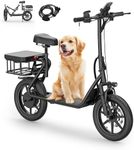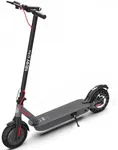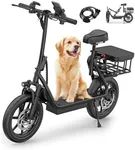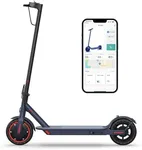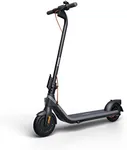Buying Guide for the Best Adult Electric Scooters
Choosing the right adult electric scooter can greatly enhance your commuting experience, providing a convenient, eco-friendly, and fun way to get around. To make an informed decision, it's important to understand the key specifications and how they align with your personal needs and preferences. Here are the main factors to consider when selecting an adult electric scooter.RangeRange refers to the maximum distance an electric scooter can travel on a single charge. This is crucial because it determines how far you can go before needing to recharge. If you have a long commute or plan to use the scooter for extended trips, look for a model with a longer range, typically 20 miles or more. For shorter commutes or occasional use, a range of 10-15 miles may be sufficient. Consider your daily travel distance and choose a scooter that can comfortably cover that distance with some buffer.
Top SpeedTop speed indicates how fast the scooter can go. This is important for safety and convenience, especially if you need to keep up with traffic or want to reduce travel time. Scooters generally have top speeds ranging from 15 to 30 mph. For urban commuting, a top speed of 15-20 mph is usually adequate. If you need to travel on faster roads or simply prefer a quicker ride, look for models that offer higher speeds. Always consider local speed regulations and your comfort level with higher speeds.
Weight CapacityWeight capacity is the maximum load the scooter can safely carry. This is important to ensure the scooter performs well and remains safe to use. Most adult electric scooters support weights between 220 to 300 pounds. Choose a scooter that can comfortably support your weight, including any additional items you might carry, such as a backpack or groceries. Exceeding the weight limit can affect the scooter's performance and durability.
Motor PowerMotor power, measured in watts, determines the scooter's ability to handle inclines and carry heavier loads. Higher wattage means more power and better performance on hills and rough terrain. Scooters typically range from 250W to 1000W. For flat urban areas, 250W to 500W is usually sufficient. If you live in a hilly area or need extra power for faster acceleration, consider a scooter with 500W or more. Match the motor power to your terrain and usage needs.
Battery Life and Charging TimeBattery life affects how often you need to recharge the scooter, while charging time determines how long it takes to recharge. Longer battery life means less frequent charging, which is convenient for daily use. Charging times can vary from 3 to 8 hours. If you use the scooter frequently, look for models with longer battery life and shorter charging times. Consider your daily routine and how often you can charge the scooter to find a balance that works for you.
PortabilityPortability refers to how easy it is to carry and store the scooter. This is important if you need to take the scooter on public transport, store it in a small apartment, or carry it up stairs. Key factors include the scooter's weight and whether it has a folding mechanism. Lightweight models (under 30 pounds) and those with a compact folding design are easier to carry and store. Consider your storage space and how often you'll need to carry the scooter when choosing a model.
Tires and SuspensionTires and suspension affect the ride quality and comfort. Solid tires are puncture-proof but can provide a rougher ride, while pneumatic (air-filled) tires offer better shock absorption but require maintenance. Suspension systems help smooth out bumps and uneven surfaces. For smooth city streets, solid tires may be sufficient. If you ride on rough or uneven terrain, look for pneumatic tires and a good suspension system. Choose based on the typical surfaces you'll be riding on.
Braking SystemThe braking system is crucial for safety, determining how quickly and effectively you can stop. Common types include electric brakes, disc brakes, and foot brakes. Electric brakes are low maintenance but may not be as powerful. Disc brakes offer strong stopping power and are reliable in various conditions. Foot brakes are simple but less effective at high speeds. For urban commuting, a combination of electric and disc brakes is ideal. Consider your speed and typical riding conditions when choosing the braking system.
Build Quality and DurabilityBuild quality and durability determine how long the scooter will last and how well it can withstand daily use. Look for scooters made from high-quality materials like aluminum or steel, which offer better durability. Check for features like water resistance, which can protect the scooter in wet conditions. Consider the reputation of the brand and read reviews to gauge the scooter's reliability. Choose a model that can handle your daily usage and environmental conditions.



